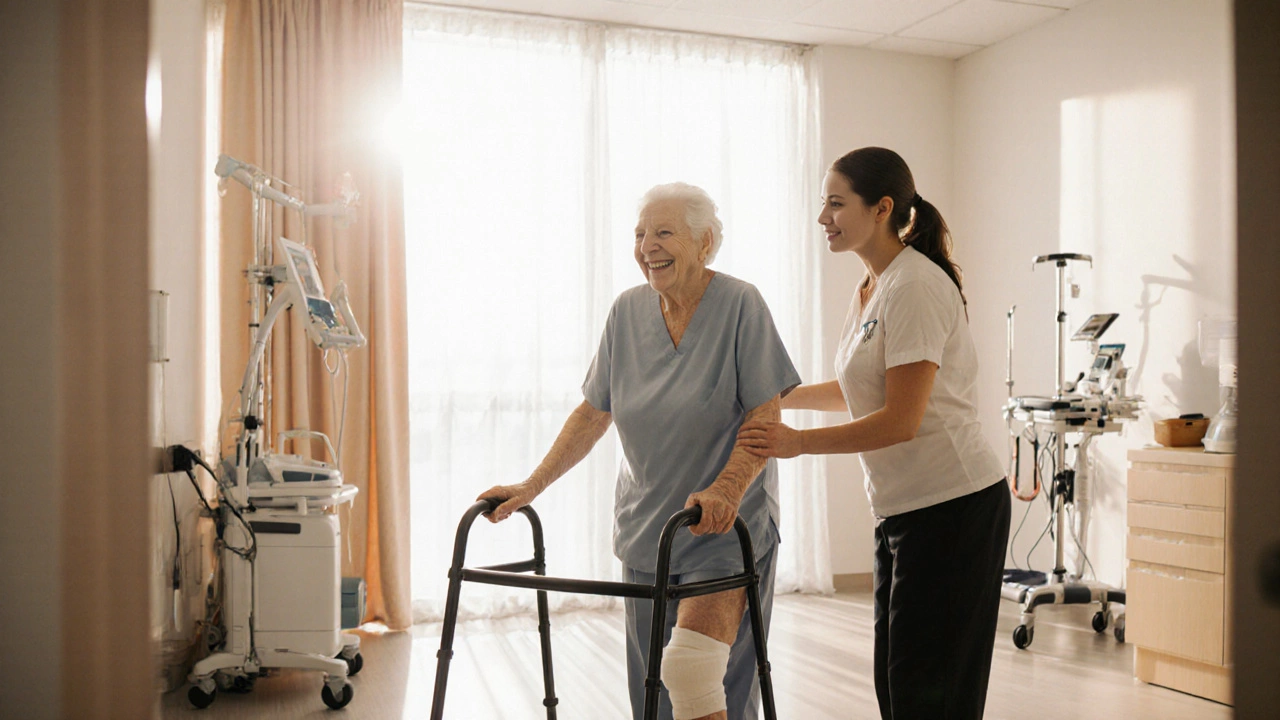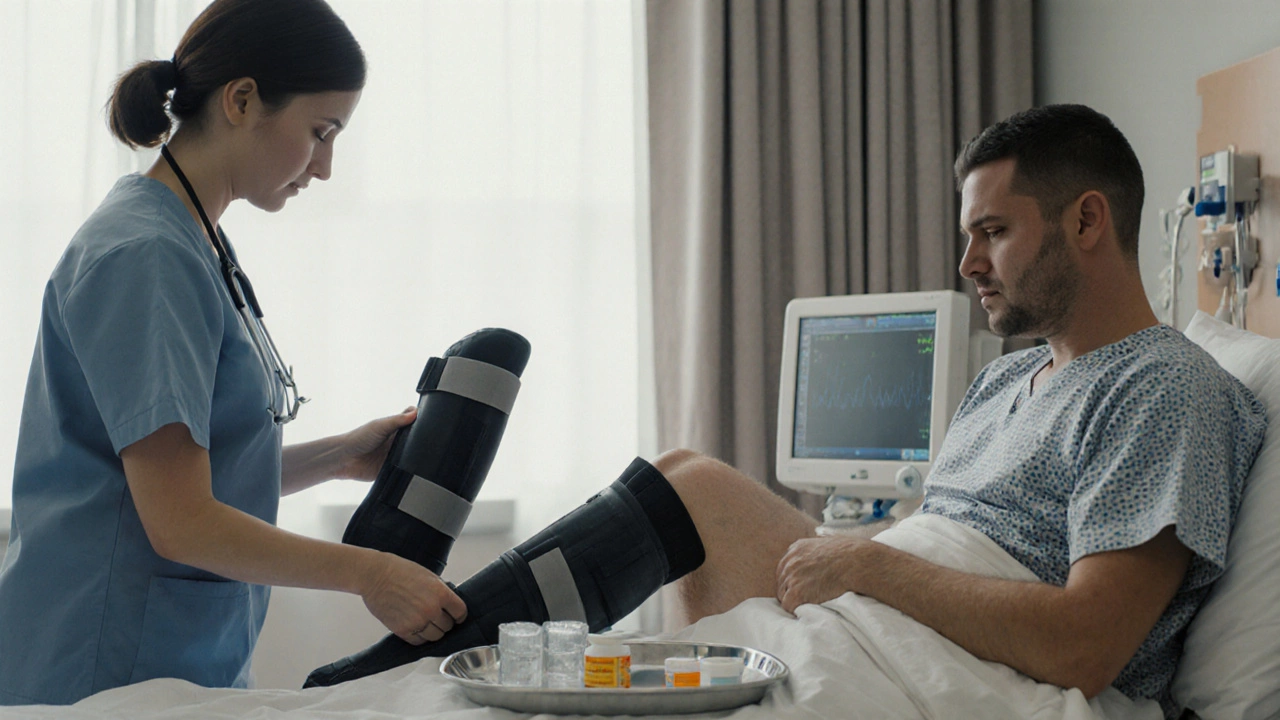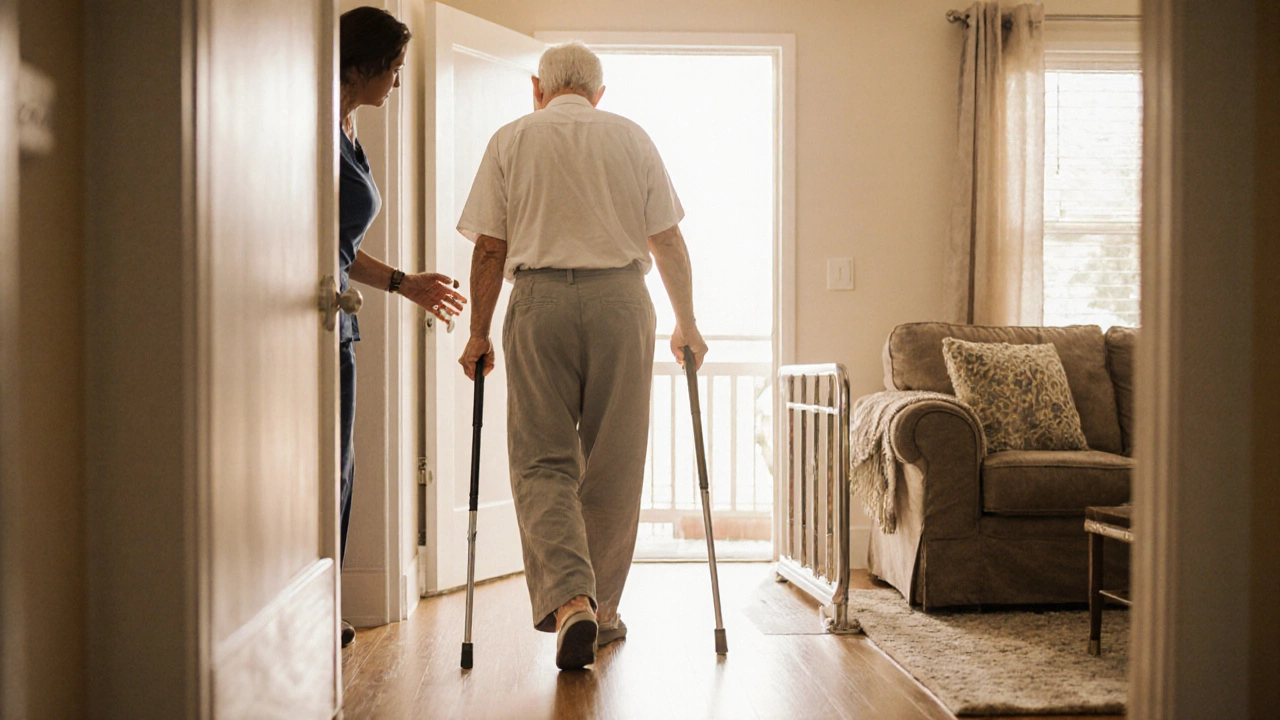- Home
- Orthopedics
- How Long Do You Stay in Hospital After Full Knee Replacement?

How Long Do You Stay in Hospital After Full Knee Replacement?
Knee Replacement Hospital Stay Calculator
How long will you stay in the hospital?
Estimate your likely hospital stay duration after knee replacement surgery based on key factors from your medical team.
Estimated Hospital Stay
Your estimated hospital stay duration will appear here...
Key discharge criteria:
- Walk with walker/crutches without help
- Bend knee at least 90 degrees
- Get in and out of bed safely
- Pain controlled with oral medications
Most people stay in the hospital for 1 to 3 days after a full knee replacement. But that number isn’t the same for everyone. Some leave the same day. Others stay longer. It depends on your age, how healthy you were before surgery, how well you move after the operation, and whether you have help waiting for you at home.
Why the hospital stay isn’t one-size-fits-all
Back in the 1990s, patients stayed in the hospital for a full week after knee replacement. That’s not the case anymore. Advances in pain control, faster-recovery techniques, and better training for staff mean most people are mobile and stable enough to go home much sooner.
But here’s what really matters: your ability to walk with help, bend your knee past 90 degrees, get in and out of bed safely, and manage pain without strong IV meds. If you can do those things by day two or three, you’re usually cleared to go home.
Some hospitals now offer same-day discharge for healthy, younger patients - especially if they have someone at home to help them for the first few days. A 65-year-old with no other health issues and a supportive family might leave the same afternoon. A 78-year-old with diabetes and high blood pressure might need an extra day or two to make sure everything’s stable.
What happens in those first 24 to 48 hours?
You won’t be lying in bed for long. Physical therapists will be at your bedside within hours of surgery. They’ll help you sit up, swing your legs over the side of the bed, and take a few steps with a walker. You’ll do this multiple times a day.
Nurses will check your vital signs, watch for swelling or bleeding, and make sure you’re not developing a blood clot. You’ll get blood thinners, usually in pill form, and compression boots on your legs to keep blood moving.
Pain control has changed a lot. Instead of relying on opioids, most hospitals now use a mix of nerve blocks, acetaminophen, anti-inflammatories, and cold therapy. Many patients report feeling less pain now than they did five years ago.
By the end of day one, you should be able to walk 50 to 100 feet with a walker. By day two, you’ll likely be climbing stairs with help. That’s the real test. If you can safely go up and down a flight of stairs, you’re ready to go home.
When do you go home?
Doctors don’t just look at time. They look at function. Here’s what they check before discharge:
- You can walk with a walker or crutches without help
- You can bend your knee at least 90 degrees
- You can straighten your leg fully
- You can get in and out of bed, the toilet, and a chair by yourself
- Your pain is controlled with oral meds
- You’re not running a fever or showing signs of infection
- You have someone at home who can help you for at least the first week
If all these boxes are checked, you’ll be discharged. Most people leave on day two. About 15% go home the same day. Less than 10% stay longer than three days - usually because of complications or lack of home support.

What if you can’t go home right away?
If you live alone, have no one to help you, or your home isn’t set up for recovery (no grab bars, steps to navigate, no downstairs bathroom), you might be sent to a short-term rehab facility. These are called skilled nursing facilities or inpatient rehab centers.
In these places, you’ll get daily physical therapy, help with dressing and bathing, and round-the-clock nursing care. Most people stay 5 to 10 days there before going home. It’s not because you’re healing slower - it’s because your environment isn’t safe yet.
Some insurance plans, including NHS in the UK, cover this short-term rehab if your doctor says it’s medically necessary. You won’t be stuck in the hospital longer than needed - you’ll just move to a different setting that’s better for your recovery.
What happens after you leave the hospital?
Going home doesn’t mean you’re done with care. In fact, the hardest part often starts now.
You’ll need to keep doing your exercises - at least twice a day. Your therapist will give you a sheet with stretches and strengthening moves. Skipping them slows your recovery. Many people feel better after two weeks, but full recovery takes 3 to 6 months.
You’ll have a follow-up appointment with your surgeon around 2 to 4 weeks after surgery. They’ll check your incision, take an X-ray, and see how your knee is moving. Blood tests might be done to check for signs of infection or inflammation.
Most people stop using walkers or crutches by week 4. By week 6, many are driving again - if they had surgery on their right knee and drive an automatic car. You’ll still feel some stiffness and swelling for months, but it gets better every week.

Red flags that mean you need to call your doctor
Not every ache or ache means something’s wrong. But these signs do:
- Fever over 38°C (100.4°F)
- Redness, warmth, or pus coming from the incision
- Sudden swelling in your calf or thigh
- Chest pain or shortness of breath
- Severe pain that doesn’t improve with medication
These could mean infection, a blood clot, or a problem with the implant. Don’t wait. Call your surgeon or go to urgent care. Early treatment makes all the difference.
How to speed up your recovery
You can’t rush healing, but you can make it smoother:
- Walk every day - even if it’s just around the house
- Keep your leg elevated when resting to reduce swelling
- Stay hydrated and eat protein-rich foods to help tissue repair
- Don’t sit for more than 45 minutes at a time - get up and move
- Use ice packs on your knee for 15 minutes, 3 times a day
- Follow your exercise plan like a job - no skipping days
People who stick to their rehab plan recover faster and have better long-term results. Those who don’t often end up with stiffness, limping, or even needing another surgery later.
What about long-term outcomes?
Most knee replacements last 15 to 20 years. Some last longer. The key is staying active without overdoing it. Low-impact activities like walking, swimming, and cycling are ideal. Avoid high-impact sports like running or jumping.
Weight matters too. Every extra pound puts 3 to 4 times more stress on your new knee. If you’re overweight, losing even 5 to 10 pounds can make your knee feel better and last longer.
By 6 months, most people say they’re back to doing the things they love - gardening, playing with grandchildren, walking the dog, or just walking without pain.

Arnav Singh
I am a health expert with a focus on medicine-related topics in India. My work involves researching and writing articles that aim to inform and educate readers about health and wellness practices. I enjoy exploring the intersections of traditional and modern medicine and how they impact healthcare in the Indian context. Writing for various health magazines and platforms allows me to share my insights with a wider audience.
Popular Articles
About
Medical Resource Center India is a comprehensive online platform dedicated to providing reliable health information and medical resources in India. Explore a wide range of articles, tips, and advice on medicine, healthcare services, and wellness. Stay informed about the latest developments in Indian medicine and access valuable insights into maintaining a healthy lifestyle. Discover expert guidance and health solutions tailored for every Indian citizen. Your go-to destination for authoritative medical knowledge in India.






